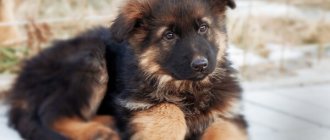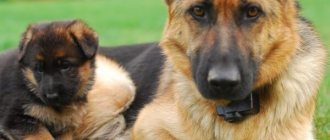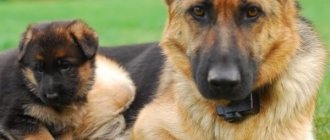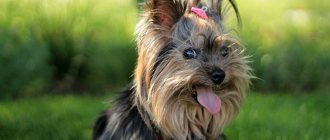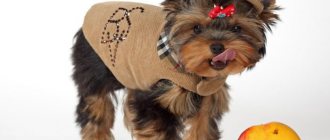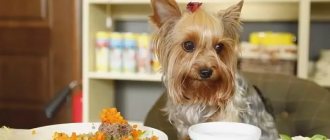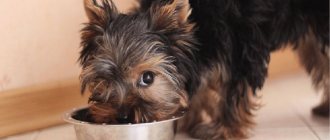You are about to buy a small Yorkshire Terrier puppy! At what age is it better to buy miniature breed puppies, especially if you plan to buy a mini Yorkie? Someone is basically looking for puppies aged 1.5 to 2 months, but maybe it’s worth thinking about it, weighing everything and opting for a grown-up puppy or an adult dog? Most people will, of course, choose a small puppy, but before you fall in love with a tiny bundle, think about whether you can take care of the baby and withstand all the inconveniences until your pet grows up.
At what age should I get a Yorkshire Terrier puppy?
Once you have decided to get a Yorkshire Terrier, you need to decide on the age of the puppy.
In this article you will find out what age is optimal. The first thought that needs to be established is that a puppy of any age requires attention, time and responsibility. Therefore, the age of the puppy, in fact, has no fundamental significance for a person who does not have the listed qualities and resources. In order to understand at what age to adopt a Yorkshire Terrier puppy, it is important to decide how much time you are willing to devote to him at this stage. The principle here is as follows: the younger the puppy, the more time and attention you will need to devote to him. At the same time, this principle does not work in the opposite direction. Those. As your Yorkie grows up, you will not be able to spare yourself a certain amount of daily diligence in raising and caring for your puppy.
And yet, at what age is it best to adopt a Yorkshire Terrier puppy? We believe that the optimal age is 3.5-4 months. There are certain additional “inconveniences” that you should be prepared for if you decide (or circumstances so arise) to adopt a puppy under 3 months old.
In this case, the puppy cannot be left at home for a long time. You will need to enlist the support of your household and adjust your schedule at home in such a way that you can minimize the puppy’s time alone. Especially immediately after you bring him to your own home - a new and completely unknown world for a small and defenseless creature. An allegory is completely appropriate here, according to which you assume the role of not only a friend, but also a protector, mentor, and parent of a Yorkshire Terrier puppy. Remember that during this period of time (up to 30 days on average), the puppy may be extremely “missing” his biological mother and brothers. After 4 months, the puppy gradually gets used to its new environment.
If you nevertheless decide to adopt a Yorkshire Terrier puppy up to 3.5 months old, you will need to:
– stay at home most of the day (you or someone else);
– feed the puppy 4-5 times a day (in extremely small portions);
– clean up after the puppy until he is accustomed to the diaper (with frequent consumption of food and water, the puppy will often “go to the toilet”);
– constantly be in special attention (the puppy will constantly strive to tuck under your feet; out of habit, you will need to switch to a somewhat new mode of moving around the house “constantly look at your feet,” especially in poorly lit places);
– be prepared to care for the puppy not only during the day, but also at night (the puppy may often wake up at night, whine, and attract your attention);
– do the necessary vaccinations yourself;
– constantly show patience and understanding towards a small living creature (under no circumstances should you lose your temper).
Agree, all of the above is a certain “inconvenience”. Especially for a person who led a “working” lifestyle. Therefore, if you take a puppy at the age of 3.5-4 months, the burden of responsibility and care falls on the previous owners, who will probably be able to handle the puppy better until it grows up and becomes a little independent. If you like the puppy, you don’t have to buy it right away. You can agree with the owners about purchasing it after a certain period of time by making a reservation.
Some believe that by adopting a puppy at the age of 6 months, all the inconveniences associated with raising and caring for it will be behind you. The arguments include the absence of “concerns”, the final color and character of the puppy. However, we would not recommend that you do this. The dog grows and develops with the person next to it, its habits and habits are determined by the owner at the age of 3-6 months. Therefore, after this period of time, you risk taking into your home a Yorkshire Terrier that is no longer yours. Since you have decided to get a Yorkshire Terrier, just try to mentally translate all the “inconveniences” associated with caring for a small puppy into “joy.”
If this is your first pet, you must definitely decide on the puppy’s age – 3.5-4 months. Your experience in getting a dog and a responsible attitude may allow you to lower the puppy’s age limit to 2.5-3 months and take home a little happiness a little earlier.
In our section of Private advertisements, we mainly find puppies 2.5-4 months old. You are sure to find the right charming living creature for yourself.
————————————————————————————————————————————
We are trying very hard for you! Please support us and become our subscribers. Latest news and important updates on VKontakte and Twitter.
Read @yorkshir_by #york in Belarus; #Yorkshire in Belarus; #Yorkshire Terrier in Belarus; #Belarusian site about the Yorkshire terrier; #site about the Yorkshire terrier; #site about Yorkies; #buy a Yorkie in Minsk; #buy Yorkshire terrier in Minsk
How to understand that the breeder is conscientious?
When buying a dog, an important factor is the seller’s integrity. The purity of the breed, the conditions of detention, and the health of the children depend on it. When communicating with him, you should feel love for animals.
A good breeder should:
- Show you the kennel and the conditions for keeping the dogs.
- Answer your questions openly and thoroughly, don’t be afraid of long conversations.
- Do not use puppy sniffing techniques.
- Introduce at least one parent, give detailed information about mom and dad, provide documents for them and the kids.
- Only sell dogs older than two months.
- Provide detailed instructions on feeding and caring for your pet.
- It will clarify the purpose of your purchase, in what conditions the baby will live, and whether you can provide him with proper care.
- Leave your phone number in case you have any questions.
A good breeder will not sell puppies too cheap. He must recoup his expenses for feeding and caring for their mother. The low price should alert you.
What problems can small puppies have?
Of course, it’s hard to imagine anything more attractive than a Yorkshire terrier puppy. They are so cute and charming, tiny in size and at the same time very smart, amenable to training.
When you look at a Yorkie puppy and fall under the spell of the glamorous little dog, you don’t think that as soon as the baby settles in your home, he will demand your attention. It's not the same as just playing with your Yorkshire terrier for a few hours.
Sometimes while playing, the puppy starts to bite, and the cute prank at first becomes an annoying habit, and the puppy's cry in the middle of the night cannot be ignored. A small puppy will need at least as much attention as a child who has just learned to run. And once the puppy reaches the age of several months, his energy will seem limitless. Raising a puppy should not be left to its own devices; sometimes puppies with complex personalities need to be devoted full time. If you don't have anyone at home during the day, you may be better off not buying a puppy. Little puppies that are left unattended
Fates, even if they are in a safe zone, often find entertainment for themselves, for example, they constantly bark or gnaw on everything that is available. Additionally, miniature breed puppies need to be fed four times a day, which means they will need to go to the toilet quite often.
Puppies need to be given attention and exercise, and then you can raise a strong and healthy pet for the whole family. The puppyhood period is very short - especially for toy dogs, and the worst will be over when the puppy reaches the age of six months, the most important thing is love and patience.
You can begin training your baby almost immediately, from the first days the puppy is in your home, and continue on an ongoing basis throughout your pet's life. The puppy will grow up next to you and you will have a connection, mutual understanding with the little Yorkie, and if you do everything right, you will be able to raise the puppy into the perfect dog.
Care and maintenance
Before you bring a puppy into the house and start caring for him, you need to prepare the apartment for the arrival of a new friend and purchase the necessary things. Remove everything from the floor that a curious dog could chew on, hide the wires and, for a while, give up carpets: the dog is not yet toilet trained and may cause mischief.
A little Yorkie may be frightened by a new environment. You need to give him time to get comfortable and get used to you.
List of things you need when your pet arrives in your home:
- aviary or bed;
- two bowls for water and food;
- toys: rubber balls, squeakers and bones made from veins;
- hair care products;
- comb, hairpins and elastic bands;
- scissors and nail file;
- bag - carrying.
Over time, you will need to buy clothes for walking and a collar with a leash. You need to take your puppy outside gradually. To begin with, short walks of 15–20 minutes in a quiet and peaceful place, while the dog should be held in your arms. When the baby grows up and gets comfortable, you can walk him on a leash twice a day.
Adult Yorkshire Terriers
Sometimes such Yorkies are also sold; when buying an adult Yorkshire Terrier, it is important to pay attention to the temperament, because sometimes such dogs are sold due to their bad, quarrelsome character. If the dog has a good character, then it will very soon become a new member of the family; such Yorkies are well suited for older people as a companion. Sometimes miniature breed dogs are given into good hands, for example due to the birth of a child or a move. If you surround such a dog with love and care, it will reciprocate and you will have another devoted friend who will never betray you.
A good and, moreover, beautiful Yorkshire Terrier will never be left without love and care; such Yorkies, as a rule, quickly find a new home and loving owners. If you want to buy a Yorkshire Terrier puppy that will love you and be your friend for many years, take your choice seriously so as not to be disappointed in the future.
Our kennel has charming Yorkshire Terrier puppies for sale.
If you are just planning to buy a Yorkshire Terrier puppy, take a look at the PUPPIES FOR SALE page, maybe your baby is already waiting for you. The nursery is preparing for sale beautiful Yorkshire Terrier puppies with a baby-face doll face from beautiful parents. The nursery currently sells two miniature boys. All puppies have a pedigree, without marriage, the babies are branded - now the puppies can be viewed and reserved.
You can find out more about the puppies by calling Irina
Yorkshire Terrier
First of all, you should decide who you want: gender, age, purpose of acquisition (for breeding, for exhibition or a pet), character. If a dog is purchased for an exhibition (i.e. it will try to take prizes there), it is not a fact that it will be bred. You will need to find out the names of the parents, the name of the club or nursery, the name of the breeder and the date of birth of the litter. All this will be needed to verify the data. Well-known breeders and nurseries will never sell their puppies near the metro station or take them outside to your car. Don’t be surprised if the breeder asks you a couple of questions about your family and in what conditions the pet will live. A veterinary passport is attached to the puppies filled with vaccinations, stickers and a hologram. Be sure to check the brand and pedigree documents of the puppy and its parents.
The most important thing is that the animal must be healthy, the eyes of a healthy animal must shine, its fur is shiny, and it emits a pleasant, faint puppy smell. The skin should not have bald spots or dandruff. Also look carefully at the texture of the coat. The correct coat of a Yorkshire Terrier should not be “puffy”, that is, it should not have undercoat.
Carefully check the fontanel; by three months it should already be closed. Examine the eyes; there should be no smudges or purulent discharge in their corners or around them. They shouldn't come from the nose either.
When purchasing a Yorkshire terrier for an exhibition, you should remember that when assessing exhibition participants, experts are guided by the breed standard, and not by emotions. Most of them have a shortened muzzle, but never a baby face.
For breeding, choose larger dogs - in the future they will give strong and viable offspring. If you want to “breed” your bitch in the future (i.e. give birth to puppies), then you absolutely cannot take a small dog. The normal weight of an adult dog for childbirth is from 2.5 kg. Of course, a 2-kilogram dog will give birth, but problems may arise. If you are not going to do this, then the size of the dog does not matter.
If you want to buy a pet for your soul, be guided by your own taste.
It is important to decide on the color of the dog. The standard color of the Yorkshire Terrier is steel and tan. Otherwise they say – gold and silver. So, both gold and silver can be of different shades. Of course, if you take a dog to go to shows, if you want to win titles and knowledge, then you need to choose a dog with the right color. But if you don’t have such a desire, there are many options. Small Yorkshire Terriers are all born black with some red tan. As the puppy grows, you can always determine its expected color. The redder the fur on the puppy's head, the brighter the so-called gold will be. The lighter the red hair, the lighter the dog will be when it grows up. If you want to know the color of the fur on the body, look at the skin of the puppy on the back (by spreading the fur). If the skin is light, then the coat of an adult Yorkie will be light; if it is dark, giving off a blueish color, then the steel will be rich. If you take a grown-up puppy, the hair on its head may not be red, but gray. This is normal. This is the so-called “overcoloring” of the dog. This is how they exchange puppy fur for adult fur. Keep one more thing in mind. Yorkie puppies may have a LITTLE white hairs (if the puppy has a white track on the chest - this is a breeding defect that will not go anywhere if the color changes).
Before you bring the puppy home, you need to purchase: 1) An enclosure. Limit the movement of your little Yorkie in your absence using a cage or enclosure, first of all, for the safety of the dog itself! There should be free access to water and food in the enclosure, and also leave toys and treats for the baby: this way he won’t be so sad and lonely. 2) Bed. 3) Bowls (for water and food). 4) Food (ask the breeder what food the puppy is used to). In many cases, breeders provide food with them. The food should not be changed for two months to avoid problems with the gastrointestinal tract (stomach). Also, the puppy should not be overfed. 5) Toys. They must be strong and large enough so that he cannot immediately chew or swallow them. Latex toys are suitable for Yorkies. They are quite durable and elastic. Chewed toys should be removed, because... the puppy may swallow the bitten piece and choke. 6) Toilet and/or disposable diaper.
Next you will need: 1) Combs, bows, elastic bands, brushes. 2) Shampoos, balms, etc. 3) Tape measure, collar with leash. 4) Carrying. 5) Clothes.
What to look for when choosing a puppy
So, how to buy a Yorkshire Terrier without making a mistake?
Choosing a puppy is a serious matter
Age
Competent breeders offer animals for sale no earlier than 2-3 months after their birth. This is due to the fact that babies must go through the necessary period of breastfeeding, and at the time of transfer to the owner they could feed themselves. In addition, earlier weaning them from their mother has a negative impact on the health of the bitch. Those who dream of a dog for exhibitions are recommended to purchase a puppy six months old. By this time, conclusions can be drawn about the size and other characteristics of the dog.
Documentation
At the time of transfer to the owner, the cubs must undergo the first vaccination, which means they are required to have a veterinary passport, properly executed, with the necessary records and seals.
Veterinary passport for dogs
Every pedigree dog must also have a puppy card. It contains information about the puppy's parents, gender and name. The results of the certification, which each dog undergoes in the club (kennel) 45 days after birth, are also entered there. The litter is assessed by a certified dog handler. He also documents the results, entering the characteristics of each puppy into his individual document. Among other things, the “puppy” contains information about branding.
Brand
It is performed in the form of a tattoo and must be on the body of the dog submitted for activation. The mark is made once and remains unchanged throughout life. Unscrupulous breeders may offer an unbranded dog, explaining that it was a pity to subject the baby to the procedure. In such cases, it is logical to suspect that the documents for the dog are fake and therefore have no legal force. The same thing applies if the brand is not readable. As for the tattoo procedure, it is performed with an anesthetic element, so the kids do not suffer.
Why else do you need a brand on a dog?
Parent information
Personal acquaintance with the child’s ancestors is not enough; you need to look at their documents. In order not to doubt the origin of the puppy, it is important to make sure that its mother and father are dogs of the same breed.
This will insure against the purchase of a half-breed. Of course, the presence of third-party genes does not mean at all that the dog is not suitable as a pet, but, firstly, its price will be different, and secondly, you don’t have to be afraid of surprises when putting the animal up for mating. A representative of an unspecified breed, but with “corrected” metrics, can produce offspring that resemble Bobik’s yard grandfather. And then troubles cannot be avoided.
Temperament, conformation and health
Finding yourself in the company of cute little ones, you shouldn’t give in to emotions. You should choose your puppy wisely and soberly, paying attention to:
- Baby's physique and activity . These indicators will say a lot about his temperament and health. A good and strong puppy should be robust, and not a dog with a loose constitution. When a dog is lethargic, sleepy and indifferent, this is not normal, unless he has eaten well the day before. The Yorkshire Terrier is a naturally cheerful creature, playful and active.
- Coat color. It represents a combination of black and gold colors.
The coat should be black and gold
There should be no spots, with the exception of a tuft of white hair on the chest. This is acceptable, but it goes away after the first molt. You shouldn’t trust sellers who try to “pick up” a puppy of a non-standard color, promising that when he grows up, he will become like everyone else. If the dog is silver-gray or another color outside the breed standard, he will not turn into steel gray. Only a black and gold pet will acquire the correct color by the age of one and a half years. When purchasing a puppy, you can get an idea of what it will look like by looking at its parents.
- Wool quality . Ideally, it is flowing, clean and shiny. If there are curls, they will remain for life. Such a dog has a higher risk of developing mats if the owner does not care for it well. It is worth paying attention to the thickness of the cover. When there are even small bald patches or areas of thinning hair on the body, this may indicate health problems. The same thing applies if the skin is flaky, covered with dandruff, and the hairs are dry.
- Paws. They should be even, while large limbs are a sign that the puppy will grow large.
Pay attention to the paws
When walking, movements are free and coordinated, and the contour of the upper body is even. When a puppy's back has a hump, so does an adult dog's back. Signs of lameness or stiffness indicate possible joint problems that will worsen with age.
- Nose. Its tip is a black lobe, cool and wet. If the puppy recently woke up, it may be warm. Breathing is even, without grunting, sniffling and discharge from the nostrils, forming a white coating around.
- Teeth. Healthy dog gums are juicy pink, but pale ones can indicate anemia.
Yorkie's teeth
Each jaw contains six incisor teeth and a pair of fangs. The closed teeth of Yorkies resemble scissors, but the bite can also be pincer-like, which is also acceptable. Ideally, the outer part of the lower incisors, when closing, tightly touches the inner surface of the upper ones. A dog with underbite and overbite is subject to disqualification and is not allowed to breed.
- Head. It is worth paying attention to the fontanel. It is located in the parietal part and should be closed at 3 months. The fragile constitution of the dog in combination with a disproportionately large head resembling an apple, bulging eyes and an unovergrown fontanel are signs of dwarfism (dwarfism). In some cases, this may also indicate hydrocephalus, a condition that makes the animal unviable.
- Eyes. In dogs of this breed they are dark in color, with a damp sheen, and look straight.
Yorkies have dark eyes
Sticky “tears” can mean problems with the eyelids or diseases of the mucous membranes of the eyes. Cloudy smudges are dangerous because they can be symptoms of serious infections. Yorkies have black pupils, and the iris does not have spots that would indicate illness or traumatic injury. The third eyelid is hidden, but if it is visible, it should not be massive, and also show signs of ill health.
- Ears. At the age of two months, Yorkies do not have them, but in an ideal dog they should not be too large and heavy.
At the age of two months they are not worth it to Yorkies.
The edge of the auricle is healthy, covered with hair, without crusts or areas of baldness. The outside of the ear canal is clean. If the baby shakes his head and often scratches his ears, it is possible that there is a mite or inflammation there.
- The abdomen is not swollen, the skin on it is without spots or rashes. A bulge around the navel or groin area indicates a hernia that will require surgery to correct.
- External genitalia . It is important to examine the bitch's loop for inflammation. It is identified by sticky hairs. A Yorkie boy should also be fine with this if the end of the prepuce is clean. The testes are lowered, although in small individuals this happens with a delay. In the case of absolute undescendence of the testicles into the body of the scrotum, they speak of cryptorchidism. It can be one- or two-sided, but in any case it is a disqualifying sign.
Growth and development
2-3 days after birth, puppies begin to crawl. At 10-15 days their eyes open, the puppies begin to respond to light, but the retina is still poorly developed.
By 18-21 days, Yorkie babies develop a fat layer, thermoregulation appears, and they begin to respond to sharp sounds.
On days 20-24, teeth begin to erupt, and by this age the puppy begins to hear.
By the month the puppies' activity increases, they leave their “playpen” and get acquainted with their surroundings.
At 8-9 months, the change of teeth ends, and the dog begins puberty. By this age, the Yorkshire Terrier reaches its maximum height, but is still developing.
In the first months of life, puppies develop as intensively as possible; it is important to monitor weight gain in order to understand that the puppy is eating correctly and is not underweight or overweight.
Yorkie puppies weight table by month:
| Age | Micro | Mini | Standard |
| Birth weight | 80 gr | 115 gr | 160 gr |
| 1 month | 230 gr | 370 gr | 595 g |
| 2 months | 370 gr | 610 gr | 940 gr |
| 3 months | 540 gr | 850 gr | 1280 gr |
| 4 months | 710 gr | 1110 gr | 1680 g |
| 5 months | 850 gr | 1300 gr | 1990 gr |
| 6 months | 940 gr | 1450 gr | 2210 gr |
| 18 months | 1140 gr | 1820 gr | 2730 gr |
As adults, standard Yorkshire terriers reach a height at the withers of 22-24 cm, mini - 16-18 cm, micro - up to 15 cm.
What makes up the price of a particular animal?
The cost of a Yorkshire Terrier, as well as other dogs, is influenced by factors such as:
- characteristics of his parents: The more titles they have, the higher the price of the offspring.
The higher the dog's characteristics, the more it is worth
You can make sure that the baby’s ancestors had exceptional breed characteristics by looking at their documents. Moreover, this must be done when deciding on the purchase of a show and breeding class animal;
- expert assessment of the puppy itself . This is due to the fact that the mating of champions can produce not only a future show ring star, but also a completely ordinary puppy. The reason is the tricks of genetics. In this case, the baby will not be a defective dog at all, but in order not to pay extra money for him, it is important to have objective information;
- assessment of the litter as a whole. High-quality and homogeneous puppies are always more expensive;
Newly born Yorkie puppies
- gender of the pet. Female Yorkshire Terriers fetch higher prices than males. And not because of breed advantages, but because breeders see them as a promising source of income.
How to care?
During the first weeks of life, the puppies are looked after by a bitch - she feeds them, turns them over, and constantly licks them. The breeder must only ensure that the puppies do not become hypothermic or overheated, and that the bitch does not accidentally crush them.
On the 3-5th day, they need to remove the dewclaws, if any - you need to stretch the skin on the puppy’s paw and quickly cut off the extra toe with sharp office scissors, and then cauterize the wound with potassium permanganate.
NOTE! At this age, puppies do not yet react too much to pain and if the procedure is carried out correctly, they will not react to it in any way.
Around the 5th-6th day, you need to trim the nails so that they do not hurt each other or the belly and nipples of the bitch during feeding.
Puppies should not be bathed until they are 3 months old, but they must examine their eyes daily and wipe them with chamomile infusion or a special lotion.
At about a month, when the coat is quite long, the puppies need to have a hygienic haircut - use a special clipper to trim the hair in the groin area, near the genitals and anus. It is also necessary to free the upper third of the ears from fur so that they do not bend under its weight and acquire the vertical position required by the breed standard.
At the same age, you should begin raising puppies, accustoming them to a diaper or tray.
When the Yorkshire Terrier grows up and is vaccinated, he should be walked every day - this is necessary not only for the physical health of an active and energetic dog, but also for its socialization and the formation of a stable psyche.
After each walk, you need to thoroughly wash your paws and belly, and give your pet a full bath about once every 3 weeks.
You should also brush your dog daily to prevent its fur from getting tangled, and monitor the condition of its teeth, mouth, and ears.
Where is the best place to buy
It is recommended to purchase a dog from a breeder who has been professionally breeding representatives of this breed for many years. You can find one through the Internet or your local breed club. A serious nursery, as a rule, has its own website, where you can find out not only about the availability of available puppies, but also get acquainted with the health, character and maintenance of Yorkshire terriers. Here you can communicate directly with the breeder, as well as read reviews from the owners.
how to choose a Yorkie puppy
Feeding the puppy
During the first weeks of life, the diet of Yorkshire Terrier puppies includes only mother's milk.
When the puppies are 3 weeks old, you should begin introducing complementary foods consisting of preheated milk, lean meat, cottage cheese or kefir, but not more than 2 tsp. in a day.
At the age of 2-3 months, low-fat sea fish, vegetables (beets, bell peppers, pumpkin), green apples, offal, and boiled cereals should be added to the puppy’s diet.
IMPORTANT! All new foods must be introduced into the Yorkshire Terrier's diet gradually, carefully observing how the pet reacts to them.
Food for a puppy should be at room temperature or a little warmer and cut into small pieces, and if the pet is less than 3 months old, crushed to a puree.
If your puppy's diet consists of ready-made dry food, the brand should be designed specifically for Yorkshire Terrier puppies.
The diet can be free, but Yorkies are prone to overeating and obesity, so it is better to organize the diet depending on the age of the puppy:
- up to 2 months – 6 times a day;
- 2-3 months – 5 times;
- 4-5 months – 4 times;
- 6-12 months – 3 times.
A one-year-old dog needs to be fed 2 times a day - morning and evening.
The serving size is calculated based on the dog's weight - 1-2 tbsp. for every 500 grams of weight.
The puppy should always have access to clean water. It should be soft (settled or filtered); hard water can cause Yorkie urolithiasis.
When can gender be determined accurately?
Dogs are born with genitals, but it is quite difficult to distinguish males from females. To avoid making a mistake, it is better to wait 2-3 weeks, when sexual characteristics become quite pronounced. In adolescence (from 6 months), the difference between females and males can be determined not only by the appearance of the genitals, but also by behavior.
The easiest way to determine the sex of a puppy is after it reaches one month of age.
First vaccinations
Mother's milk protects newborn puppies from infections and diseases. When the feeding period ends, this protection disappears and is replaced by immunity developed by the puppies on their own.
Vaccinations are required to develop the immune system.
Any vaccination has several basic rules:
- It is prohibited to vaccinate a pregnant or lactating bitch;
- You should not vaccinate too early, otherwise it will not work and the risk of infection will increase;
- the same drug should be used for vaccination and revaccination;
- the puppy must be completely healthy.
CAREFULLY! Vaccinating a sick or weakened pet after an illness can cause death.
In addition, 7-10 days before vaccination it is necessary to carry out deworming, and the dog cannot be bathed a day before the procedure.
The standard vaccination schedule includes vaccinations against rabies, hepatitis, parvovirus gastroenteritis, distemper and leptospirosis.
Vaccination schedule:
- 1st vaccination – 8-9 weeks;
- revaccination – 10-11 weeks;
- 3rd vaccination – after changing teeth, approximately 7.5-8 months;
- rabies vaccination – 3-4 months and a year.
In the future, the Yorkshire Terrier must be vaccinated annually at the same time.
The owner chooses the vaccine for vaccination himself (usually Eurikan or Nobivak), and notes on the vaccinations performed are made in the veterinary passport.
A slight increase in temperature and refusal to eat after vaccination is a normal reaction of the body.
Are there Mini Yorkies?
Little York
No, there is no such division within the breed. This should be kept in mind by those who purchase older dogs with parameters that are not adequate for their age. In order to sell the dog, “breeders” begin to convince that it is a mini version of the Yorkshire terrier. In fact, dogs that are too small grow out of weak or the smallest puppies in the litter. Inconsistency of height and weight with breed standards makes it impossible to participate in exhibitions, and will also become an obstacle to using the dog in breeding work.
Weight and height of puppies
The breed characteristics do not indicate the average height of a Yorkie. On average, doggies grow to 15-22 cm at the withers. Normal weight: 1.3-3 kg. The normal weight of large individuals is 3.6-4 kg.
The standard weight for puppies varies depending on the breed type they are: dwarf, small, medium or large. The height at the withers is also ranked according to these types: mini - no more than 15 cm, medium group - 15-18 cm, large representatives - 16-22 cm.
Average indicators for the breed are in the following table.
| Age (months) | Approximate weight (kg) |
| Newborns | 0,09-0,1 |
| 1 | 0,3-0,5 |
| 2 | 0,4-0,9 |
| 3 | 0,6-1,3 |
| 4 | 0,8-1,7 |
| 5 | 1-2 |
| 6 | 1,1-2,5 |
| 7-12 | 1,3-3,4 |
The formula will help you calculate the weight of a puppy in the future: weight at 2 months (8 weeks) * 3. The resulting number is the approximate weight of the Yorkie upon reaching 1 year. To weigh a miniature dog, you can use a regular kitchen or floor scale.
Both excess weight and body weight dystrophy are harmful to Yorkies. If a young animal is already obese, the risk of injury, development of joint pathologies, and hypoglycemia increases. Common problems with “severe” Yorkies: luxating kneecaps, hip dysplasia.
Weight loss may indicate helminth infection, congenital pathologies, or hormonal diseases that inhibit development. A common cause is improper, insufficient feeding. If a one-year-old Yorkie weighs less than 1.3 kg, a veterinarian examination is required.
In contrast to the standard
The most popular type of Yorkie is the baby face. This is a small dog with large round eyes and a short muzzle, and it certainly looks cute. Unfortunately, the appearance goes against the standard, and the dog has a number of problems related to breathing and vision. Too large eyes contribute to poor vision due to frequent conjunctivitis. Frequent diseases of the respiratory system due to the irregular anatomical structure of the skull - short and round, and the muzzle is narrow and small. Low set ears.
Development of puppies by month
Newborn puppies are deaf and blind. They practically do not move: they sleep most of the day, the rest of the time they eat. The dogs are completely dependent on their mother - they feed on her milk and keep warm. She takes full care of their hygiene.
In order not to frighten the dog's family, a person should not pick up newborn babies or stroke them. Communication with puppies begins when they begin to see and hear and are ready to explore the world.
Photos and videos of a newborn Yorkie:
1 month
Almost immediately after birth, Yorkies have their tails docked. By the first month of life, the wound heals. At this age (10-14 days), the dogs’ eyes are already appearing and their ears are opening. Month-old puppies tend to explore their surroundings. The owner needs to make his home as safe as possible - it’s easy for a miniature puppy to get injured.
The baby gains weight rapidly - by 4 weeks it almost triples. A one-month-old puppy stops crawling funny - he can walk, and tries to run clumsily. Becomes very active - communicates with people and brothers. He is gradually weaned from his mother's milk: he is given liquid, and then softened and solid complementary foods.
Photos and videos of Yorkie 1 month:
2 months
At this age, puppies are already completely independent from their mother and go to live in a new home. The animal is ready for upbringing and socialization: the puppy is explained the rules for walking, communicating with people, and behavior in the house. For wrongdoing they reproach, ignore, and for good behavior they reward with “yummy food” and affection.
The dog is already eating solid food. It can be smoothly transferred to a new diet, different from the food in the breeder’s house: from food to natural food or vice versa. It is important to make the transition gradually to avoid digestive upset.
Photos and videos of Yorkie 2 months:
3-6 months
The little Yorkshire terrier continues to actively explore the world, learning to coexist with people and other animals. It is important for the owner to pay attention to his socialization - at this stage the dog’s character and his habits are established. Miniature and cute Yorkies can be stubborn and wayward: only education will make them obedient and kind pets.
An important physiological change: the babies' ears begin to straighten (one of the characteristics of the breed). This process does not have clear deadlines - there is nothing to worry about if it drags on.
From about 4 months, baby teeth are replaced by permanent ones: first the front ones, then the canines and molars. Just like in humans, this process is unpleasant and painful: the puppy may become capricious, lose appetite, and fall into apathy.
Photos and videos of a 3 month old Yorkie:
Photos and videos of a 4 month old Yorkie:
6-9 months
The puppy ceases to be a “child”. Translated into human standards, he enters “adolescence” with all its problems: demonstration of willfulness, stubbornness, desire to master the whole world and get to know its inhabitants. Patience is required from the baby's owner: you cannot frighten, beat, or punish the animal. This approach will “give” a timid, aggressive, distrustful Yorkie.
But the dog is always shown that the owner is dissatisfied with his faults and pranks: the person speaks in a stern tone, refuses to play and pet him for a while. Bad behavior is also associated with puberty: Yorkie girls experience their first heat.
At this time, females are sterilized if the owner does not plan to breed. It is important not to delay the operation: delay threatens the further development of breast and ovarian cancer.
Video of Yorkie 8 months:
9-12 months
The puppy becomes an adult animal: growth slows down, weight gain slows down. He is transferred to food for adult Yorkies, and the frequency of meals is reduced strictly to 1-2 times a day.
Yorkies live, on average, up to 10-12 years. However, they are considered senior dogs from 8 years of age. At this age, the owner must change the food according to the veterinarian’s prescription and provide the dog with the necessary living conditions.
Photo of Yorkie 1 year:
What explains the difference in price for puppies of the same age and breed?
Yorkshire Terriers, like other dogs, are classified into three groups, each of which has its own characteristics.
Table 1. Classification of dogs according to breed standards and application.
| Name | Signs | Application |
| Show class | A puppy from champion sires with ideal breed characteristics regarding:
| Participation in exhibitions, breeding, with the opportunity to sell offspring at the highest possible price. |
| Breed-class | A dog from producers whose breed is confirmed by documents. The animal's parameters correspond to the standard, but are not as outstanding as those of the show class representatives. A prerequisite is the absence of disqualifying signs | For participation in exhibitions (without prospects for high results), breeding work. These puppies are sold at an average price. |
| Pet class | These animals do not have exhibition or breeding prospects due to minor health problems or the presence of disqualifying characteristics (non-ideal body proportions, head shape, ear size and other anatomical defects, non-standard color). | This is a pet dog that can be bought for little money. The absence of the need for a show career significantly reduces the cost of its maintenance, since there is no need to pay for participation in exhibitions. At the same time, from the point of view of an ordinary person, the dog is quite beautiful and has a set of breed characteristics. And yet such people are not allowed to do breeding work. “Defective” dogs are sold without documents. |
Adult show class dog
Health
A small puppy is a very fragile creature. Unfortunately, sometimes babies die in the arms of their new owners in the first days. The reason is not always the breeder's deception. Often, with a sharp change in conditions, existing chronic diseases that were impossible to identify earlier become aggravated. In addition, the immature immune system suffers.
Mortality is especially high during the period of vaccination and quarantine. Moving and vaccinations are a double blow to the body; it is better to deal with this issue in advance. Responsible breeders sell only vaccinated puppies that no longer require quarantine.
Alas, it is not easy to find such people, since after the second revaccination the babies are already about 3.5 months old. Inexperienced owners try to buy very small puppies, and older pets are much more expensive. It is more profitable for breeders to sell dogs as early as possible. If you want to buy a healthy pet, try to find a vaccinated puppy.

